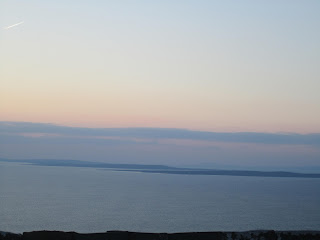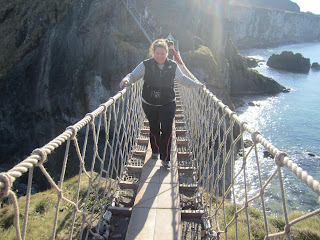Moving right along,
you can rejoin our nonstop Irish party on a brilliant April morning in
Portrush, the North.
We had had a
delicious dinner and pint and taken in the late weeknight town after settling
in the night before, and already Portrush was shaping up to be a precious
little town. When one thinks of Northern Ireland, one tends to think of car
bombs, protests, lots of orange, paintings of William and his white horse, and
people behaving crankily about flags. One does not think of glowing blue skies over
crashing cold waves and snow-capped islands, viewed through mansard windows
with particularly delicious potato toast.
We had a full docket
of Northern adventures to accomplish that day, beginning with the eminent Giant’s
Causeway.
Just a twenty-minute
drive from Portrush, the Giant’s Causeway, in case you grew up in a home devoid
of National Geographic magazines, is a fantastic geological feature that was
caused approximately fifty million years ago by a lava flow encountering a bed
of chalk and forming a sort of liquid-basalt-mud that dried and cracked like
the sediment at the bottom of a dry pond. The surface cracks eventually worked
their way down to the base of this formation, creating the mass of columns that
have been impressing human beings for centuries.
The Giant’s Causeway,
as a UNESCO world heritage site, is one of the most happenin’ tourist hubs in
all of Western Europe, but the artful visitors’ center and up-tempo tour made
it seem far less touristy than it could have been. Our guide sported a thick
Northern burr, a mixture between an Irish and Scottish accent that was at times
hard to comprehend but endlessly fascinating. In this accent, the number “eight”
is pronounced with four syllables: “ayy-iii-uh-ut”
Legend has it that
the Causeway was not in fact formed by lava flows, but instead was the creation
of two giants, Fionn MacCool of Ireland and Benandonner of Scotland. They
decided to (either, depending on the
story) wage a war against each other or connect their two lands with a bridge.
They toiled away for many years, eventually connecting the two, but based on
the unwillingness to fight of one of the combatants (with the cowardice of
Benandonner being heavily favored) the bridge was destroyed, leaving matching
basalt columns on either side of the North Channel. Here is a much more
spirited and/or hardcore retelling of the tale, complete with onomatopoeias and
first-class animation.
The Causeway drops away
into the sea and it is here that in 1588, during the Spanish Armada’s attempted
invasion of England through Ireland, one of the twenty-odd ships sailing into
the teeth of a North Sea gale was wrecked. This being a shipwreck, and a Spanish
shipwreck no less, rumors of sunken gold enticed divers to go searching the
base of the Causeway for the treasure of La Girona, a galleass whose crew, made
up of the survivors of numerous other Irish shipwrecks, was sent almost
entirely to a watery grave after their rudder broke and smashed them against
the cliffs. Nearby Dunluce castle, which will be covered later on in this post,
was the supposed site of the wreck, but it was not until the nineteen fifties
that a Belgian diver did some poking around with the local folklore and
discovered that it was not, in fact, the castle that had been sighted as the
nearest landmark to the shipwreck, but a rock known as the Giants’ chimney just
East of the Causeway that pointed to La Girona. The crags of the rock had been
mistakenly cited as the towers of Dunluce through the thick rain and wind, and this
mistake was not rectified for nearly four hundred years. It was only by
listening to the lore of the surrounding area- the peninsula under the Giants’
chimney is called, in Irish, “Spanish point,” something entirely passed over by
other treasure hunters- that our clever Belgian diver was able to recover the
loot of a thousand worlds from the briny deep.
What was the point of
that exercise, other than historical pedantry? Well, the tour guide and his
burr put forth that in this case, the legend, the story without scientific substantiation,
the far-flung possibility, turned out to be true. Perhaps, then it really was a
pair of Giants who built the Causeway with their bare hands. “Ya ken bileeve
what ye want,” he said.
I thought that that
was a nice way of putting things.
After the Causeway we
headed to the aforementioned Dunluce castle. There was not a shipwreck at this
castle (as the world now knows), but it was the castle upon which C.S. Lewis
based the palace of Cair Paravel in his celebrated Chronicles of Narnia.
Besides practically
being Narnia, Cair Parav- I mean, Dunluce was extremely well-preserved. This being
Ulster, not Munster, it was inhabited by MacDonnells, Earls of Antrim, and not
the McCarthys of the South, unlike every other castle we’ve talked about.
Dunluce is situated atop a near-island, surrounded by sheer drops to the sea
and is only reached by crossing a bridge. The impenetrable nature of the castle
kept it safe from Vikings and today makes it look extremely dramatic.
In the low-tide
saltmarsh at the base of the castle stood a towering hill, almost so tall as to
be level with the ramparts of the castle one hillock over. I trotted down the Cliffside
and climbed the hill, leading to some very cool photos of Dunluce from below. Aunt
Rita and various other visitors waved at me and shouted cautionary phrases from
the turrets as I clambered about on the slope. It was most thrilling.
 |
| There I be, on my hillock |
Have I yet mentioned
that the weather was perfect? It was. It was cold and windy but not a cloud
passed over county Antrim that day. It was impossibly lovely.
Our perfect day was
about to get better, because after climbing every inch of Dunluce castle we
made tracks inland for the town on Bushmills, the obvious home of the Bushmills
Whiskey distillery. There we had a brilliant whiskey tour and tasting. While it
didn’t quite hold a candle to the Jameson distillery fifteen minutes from Cork,
to which I have gone (and been licensed as a whiskey taster… twice), there’s
always something to be said for extending one’s epicurean horizons.
Our last stop of the
day was at the Carrick-a-Rede rope bridge, a delicate bridge (of rope, no less!)
spanning the chasm between the mainland and the appropriately-named Sheep
island, to which sheep were herded in days of yore to benefit from the lush sea
grass thereon. Tourists went galumphing across the bridge, murmuring to
themselves about not looking down, before emerging unscathed on the far side
where they could frolic about on the beneficial grasses of Sheep island. One
group of pilgrims was even doing a tai chi session. I rather love heights, so
the bridge was little trouble for me. Aunt Rita has the usual human amount of
acrophobia, and y’all should be extremely proud of her for crossing the bridge
like a champ.
That evening we
uncovered a mysteriously deserted restaurant called “The Blue Duck” overlooking
the Portrush marina and watched the sun go down over the North sea before
retiring to the hotel for an impromptu crash course in whiskey, hosted by a
burring barkeep in the hotel bar.
I will skip right
along to the next two days, wherein we covered the West coast of Ireland.
Pictures speak louder than words for this bit, for, as anyone will gladly tell
you, the beauty of the Western Shore is worth a hundred thousand words.
 We left Portrush and
went gliding through fields of sheep and tiny towns. We hit up a castle and
yarn stores in Donegal, skimmed the bays at Derry/Londonderry and Galway, found
the grave of W.B. Yeats (“Being
Irish, he had an abiding sense of tragedy, which sustained him through
temporary periods of joy”
and “The innocent and the beautiful have no enemy but
time”) at Drumcliff
in county Sligo, wound through Galway's barren, craggy Burren, passed under Croag Patrick, and crossed the broad majestic Shannon by ferry. While we didn’t
see any of the famed river dolphins, the smokestacks of the huge hydroelectric
power plants that brought light, heat, and running water quite suddenly to
rural Ireland in the nineteen fifties made my heart leap about like a merry
ocean creature.
We left Portrush and
went gliding through fields of sheep and tiny towns. We hit up a castle and
yarn stores in Donegal, skimmed the bays at Derry/Londonderry and Galway, found
the grave of W.B. Yeats (“Being
Irish, he had an abiding sense of tragedy, which sustained him through
temporary periods of joy”
and “The innocent and the beautiful have no enemy but
time”) at Drumcliff
in county Sligo, wound through Galway's barren, craggy Burren, passed under Croag Patrick, and crossed the broad majestic Shannon by ferry. While we didn’t
see any of the famed river dolphins, the smokestacks of the huge hydroelectric
power plants that brought light, heat, and running water quite suddenly to
rural Ireland in the nineteen fifties made my heart leap about like a merry
ocean creature.


We stopped at sunset
at the Cliffs of Moher. Again, there are not words.
 The Cliffs are
perhaps the single biggest draw for visitors to Ireland outside of Dublin, and
this is no surprise. They are absolutely majestic, tall and wide as far as the
eye can see, dropping down into mist and clouds of wheeling seabirds. We liked
them so much we came back the next day for a few hours to see them in broad
daylight. I don’t know which lighting was more stunning.
The Cliffs are
perhaps the single biggest draw for visitors to Ireland outside of Dublin, and
this is no surprise. They are absolutely majestic, tall and wide as far as the
eye can see, dropping down into mist and clouds of wheeling seabirds. We liked
them so much we came back the next day for a few hours to see them in broad
daylight. I don’t know which lighting was more stunning.  |
| I live life on the edge. |
 That night we rolled
into the town of Lahinch and happily stumbled across Vaughan’s, one of Ireland’s
top-ranked restaurants, quite by serendipity. Our hotel was equally awesome and
besides a wee bit of trouble in not crashing through the entrance arm to the
parking lot, everything continued to go perfectly.
That night we rolled
into the town of Lahinch and happily stumbled across Vaughan’s, one of Ireland’s
top-ranked restaurants, quite by serendipity. Our hotel was equally awesome and
besides a wee bit of trouble in not crashing through the entrance arm to the
parking lot, everything continued to go perfectly.  |
| Back on the Iveragh Peninsula! |
Our next day, fifth
in the trip, took us down the rest of the way to Kerry, which you as a
tried-and-true reader of the Irelandiary will recognize from a pair of posts
waaaaaayyyyyy back in February. Yes, we had made it, once again, to
Cahirsiveen, and it is there I will leave you for next post, we shall discuss
perhaps the pinnacle of my Irish adventures before or since: climbing, at long
last, Skellig Michael.
Until then!























.JPG)



Absolutely Beautiful!! I am thoroughly enjoying every word. You are bringing our trip back to life!! Thank you!! ~Aunt Rita
ReplyDelete